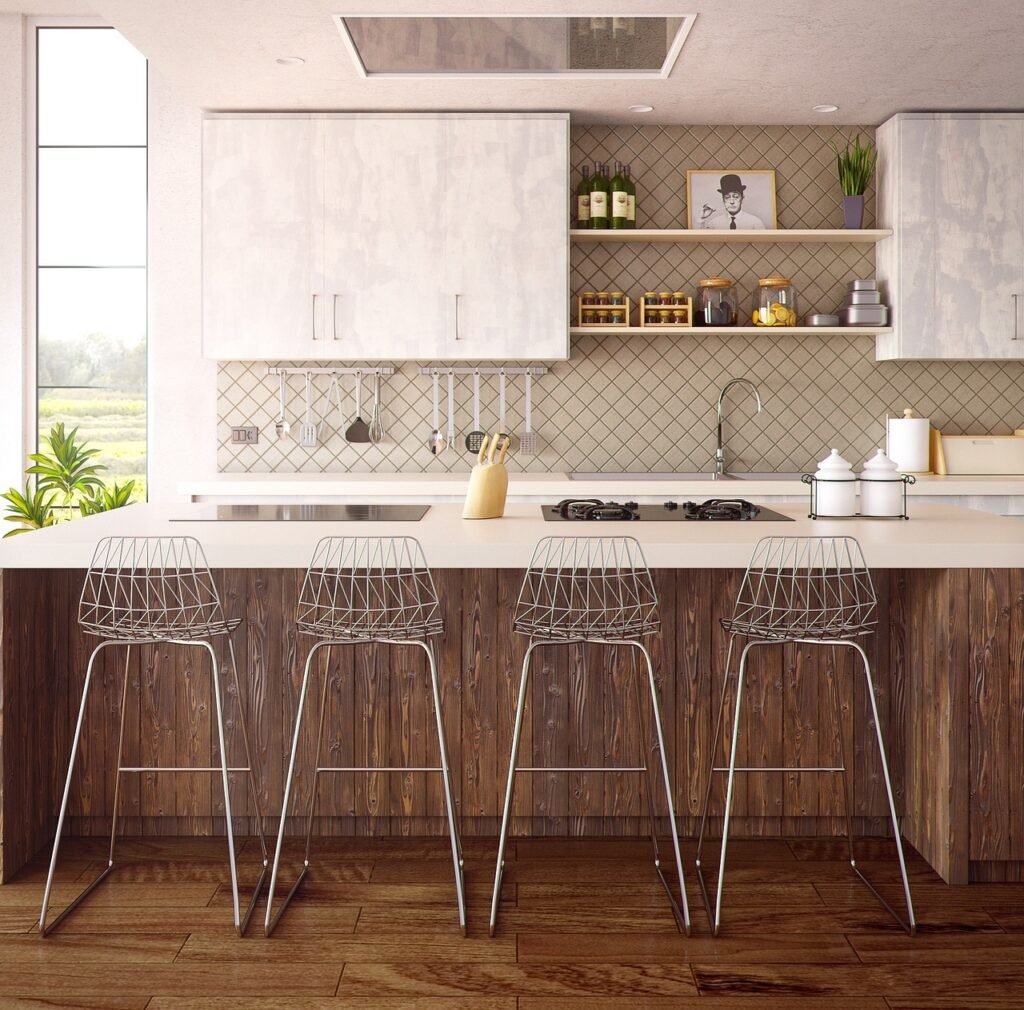After managing residential properties and consulting on kitchen optimization projects for over twenty-eight years, I’ve discovered that the best kitchen carts for portable storage and serving convenience represent far more than mobile furniture—they’re strategic investments in kitchen efficiency and entertaining capability that most people completely underestimate. The wrong cart choice can create workflow disruption, storage frustration, and maintenance challenges that undermine kitchen functionality.
What separates successful kitchen cart investments from disappointing purchases is understanding the relationship between mobility engineering, storage capacity, and multi-functional design that either enhances or restricts kitchen operations. I’ve witnessed countless situations where homeowners invested in attractive but impractical carts that couldn’t accommodate their cooking routines or created safety hazards due to poor stability engineering.
The reality is that creating truly functional kitchen mobility requires strategic cart selection based on proven workflow principles rather than aesthetic preferences alone. The best kitchen carts for portable storage and serving convenience must deliver measurable performance across multiple categories—storage optimization, structural stability, material durability, and serving functionality—while accommodating various kitchen sizes and cooking styles. From compact galley kitchens to spacious culinary environments, I’ve seen how thoughtful cart choices can transform cooking experiences and enhance entertaining through sophisticated mobility engineering and strategic storage design.
Mobility Engineering and Wheel Performance Standards
Look, the engineering behind effective kitchen cart mobility isn’t negotiable—decades of commercial kitchen research have established that quality caster systems determine both safety and functionality more than any other design element. The best kitchen carts for portable storage and serving convenience incorporate industrial-grade wheels with locking mechanisms that provide smooth movement across different flooring surfaces while maintaining stability during stationary use. Quality caster systems use ball-bearing construction, appropriate weight ratings, and materials that resist kitchen environment challenges including moisture, grease, and temperature variations. What I’ve learned from restaurant equipment specialists is that wheel failure creates dangerous situations and renders carts unusable, making caster quality essential for long-term functionality. Smart buyers prioritize proven wheel technology over decorative features because mobility affects both safety and daily usability in ways that determine overall cart effectiveness and user satisfaction.
Storage Capacity Optimization and Organization Systems
Here’s what most people get wrong about kitchen cart storage: they focus on total capacity rather than understanding organization systems and accessibility patterns that determine actual storage effectiveness during daily cooking activities. The best kitchen carts for portable storage and serving convenience utilize multi-tier shelving, adjustable components, and specialized storage zones that accommodate different kitchen items while maintaining easy access during meal preparation and serving activities. Strategic storage design includes consideration of appliance sizes, cookware dimensions, and frequently used items that require immediate accessibility. What consistently works across different cooking styles is choosing carts with flexible storage configurations rather than fixed layouts that may not accommodate changing kitchen needs over time. Quality storage systems include features like spice racks, towel holders, and utensil hooks that maximize utility while preventing clutter accumulation that reduces cart effectiveness and kitchen workflow efficiency.
Material Selection and Kitchen Environment Durability
Most people underestimate how dramatically material choice affects both performance and longevity in demanding kitchen environments that include heat, moisture, and frequent cleaning requirements. The best kitchen carts for portable storage and serving convenience utilize materials that resist kitchen-specific challenges while maintaining appearance standards and structural integrity through years of daily use and cleaning cycles. Stainless steel surfaces provide professional durability and easy sanitization, while sealed hardwoods offer warmth and character with proper moisture resistance. Quality materials resist staining, bacterial growth, and chemical reactions with cleaning products that can degrade inferior surfaces over time. What separates kitchen-grade materials from residential furniture is attention to food safety requirements, cleaning compatibility, and performance under demanding use conditions that characterize active cooking environments. Smart material selection includes consideration of maintenance requirements, replacement costs, and long-term appearance retention that preserves both functionality and aesthetic appeal.
Multi-Functional Design and Serving Versatility
Here’s where many kitchen cart purchases fail: buyers focus on storage capacity while ignoring serving functionality and workspace versatility that determine whether carts enhance or complicate entertaining and meal service activities. The best kitchen carts for portable storage and serving convenience incorporate design features that facilitate food preparation, serving, and dining support through thoughtful surface planning and accessibility optimization. Quality multi-functional design includes appropriate work surface heights, food-safe materials, and serving accessories that transform carts from storage solutions into active kitchen participants. What I’ve observed across different entertaining styles is that versatile carts adapt to various roles—prep station during cooking, serving platform during meals, and storage solution during cleanup phases. As featured in lifestyle publications like
Services Paper, the trend toward multi-functional kitchen equipment reflects growing demand for space-efficient solutions that enhance rather than complicate culinary activities and entertaining experiences.
Size Planning and Space Integration Strategies
Most people approach kitchen cart sizing with current space assumptions rather than understanding traffic flow requirements and future needs that determine long-term satisfaction and functionality. The best kitchen carts for portable storage and serving convenience require strategic size selection that provides adequate storage and workspace while maintaining kitchen mobility and accessibility during daily cooking activities. Standard cart dimensions range from compact 16-inch widths for narrow spaces to island-sized 30+ inch options for spacious kitchens with different entertaining requirements. What works consistently across different kitchen layouts is choosing carts that complement rather than compete with existing workspace while providing meaningful storage and serving enhancement. Quality size planning considers door clearances, appliance access, and movement patterns that affect both daily functionality and safety during busy cooking periods when multiple family members use kitchen spaces simultaneously.
Assembly Requirements and Maintenance Considerations
Here’s what nobody talks about regarding kitchen cart ownership: assembly complexity and ongoing maintenance requirements significantly affect both initial satisfaction and long-term performance, yet most buyers never consider these factors during selection processes. The best kitchen carts for portable storage and serving convenience feature straightforward assembly procedures and maintenance requirements that match user capabilities and time availability for upkeep activities. Quality construction includes clear instructions, appropriate hardware, and design features that facilitate both assembly and ongoing care without requiring specialized tools or professional assistance. What consistently delivers the best ownership experience is choosing carts with proven assembly systems and maintenance approaches rather than complex designs that create frustration and discourage regular use. Smart maintenance planning includes consideration of cleaning requirements, adjustment needs, and component replacement that preserve cart functionality and appearance. As discussed in health and wellness publications like First Health Diary, the connection between proper kitchen equipment maintenance and food safety makes care requirement evaluation essential for kitchen cart selection.
Safety Engineering and Stability Performance
Most people approach kitchen cart safety with assumptions rather than understanding stability engineering and weight distribution principles that determine performance under loaded conditions and dynamic use scenarios. The best kitchen carts for portable storage and serving convenience incorporate safety features through base design, weight capacity planning, and stability systems that prevent tipping and sliding during normal kitchen activities and emergency situations. Quality safety engineering includes appropriate weight ratings, center-of-gravity considerations, and structural reinforcement that maintains stability when fully loaded with kitchen items and serving materials. What separates safe carts from hazardous alternatives is attention to real-world use patterns, floor surface variations, and user interaction scenarios that affect stability and safety performance. Smart safety planning includes consideration of loading patterns, user demographics, and kitchen environment factors that influence cart stability and safety requirements during daily use and entertaining activities.
Investment Analysis and Long-Term Value Assessment
Most people approach kitchen cart purchases with unrealistic expectations about performance lifecycles and total functionality value that lead to budget compromises undermining effectiveness or excessive spending on features that don’t enhance daily kitchen operations. The best kitchen carts for portable storage and serving convenience represent investments in kitchen efficiency and entertaining capability that should provide consistent performance for 8-15 years with proper selection and maintenance, making cost-per-use calculations more relevant than initial purchase prices alone. Quality kitchen carts in the $150-500 range typically offer superior long-term value compared to budget alternatives that may appear adequate initially but lack the construction quality and feature sophistication necessary for demanding kitchen applications. What I always tell clients is that cart functionality affects cooking efficiency, entertaining confidence, and kitchen organization in ways that justify strategic investments in proven quality rather than accepting compromises that create ongoing frustration. The key insight is that mobility and storage quality compound over time through enhanced functionality and reduced replacement needs, making quality investments financially beneficial beyond convenience considerations. As reported in statistical publications like Statistics Wire, the correlation between kitchen equipment quality and user satisfaction demonstrates the importance of strategic investment in mobility and storage solutions.
Conclusion
Selecting the best kitchen carts for portable storage and serving convenience requires understanding the complex relationships between mobility engineering, storage optimization, and safety performance that affect both daily kitchen functionality and entertaining success. The most successful kitchen cart investments result from prioritizing quality construction and proven functionality over aesthetic preferences alone while ensuring proper integration with existing kitchen workflow and space requirements.
What I’ve learned from working across residential and commercial kitchen applications is that kitchen carts represent strategic investments in cooking efficiency and entertaining capability that affect meal preparation, storage organization, and social gathering quality in measurable ways. The benefits extend far beyond basic storage functionality to include enhanced workspace flexibility, improved serving capabilities, and mobility solutions that transform kitchen operations and entertaining experiences.
The kitchen equipment market continues evolving with new materials, safety innovations, and convenience features that make effective kitchen mobility more accessible than ever before. However, the fundamental principles of quality construction, proper sizing, and safety engineering remain constant guides for smart purchasing decisions. Success comes from understanding cooking patterns and entertaining needs while investing in materials and features that deliver consistent performance throughout years of daily use in the home’s most active workspace.
What size kitchen cart works best for average-sized kitchens?
Carts measuring 24-30 inches wide provide optimal balance between storage capacity and kitchen mobility for most spaces. This size offers meaningful storage enhancement while maintaining clearance for appliance access and traffic flow. Consider kitchen doorways, cabinet spacing, and movement patterns when selecting dimensions for safe daily operation.
Which wheel types provide the best performance for kitchen cart mobility?
Industrial-grade casters with ball-bearing construction and locking mechanisms offer superior performance across different flooring surfaces. Look for wheels rated for kitchen environments that resist moisture and grease while providing smooth movement. Quality caster systems include at least two locking wheels for stability during stationary use.
What materials offer the best durability for kitchen cart construction?
Stainless steel surfaces provide professional-grade durability and easy sanitization, while sealed hardwoods offer aesthetic appeal with moisture resistance. Avoid untreated wood or basic plastics that can’t withstand kitchen environment stresses. Choose materials with proven food service applications and cleaning product compatibility for optimal longevity.
How much storage capacity should I expect from quality kitchen carts?
Multi-tier designs typically provide 15-25 cubic feet of storage across shelves, drawers, and specialized compartments. Look for adjustable shelving systems that accommodate different item sizes and changing storage needs. Consider vertical space utilization and organization features that maximize utility beyond basic storage volume measurements.
What safety features are essential for kitchen cart stability and performance?
Wide base designs, appropriate weight distribution, and quality locking casters prevent tipping and sliding during normal use. Look for documented weight capacity ratings and stability testing certification. Consider center-of-gravity factors when loading carts and choose models with reinforced construction that maintains stability under maximum recommended loads.







